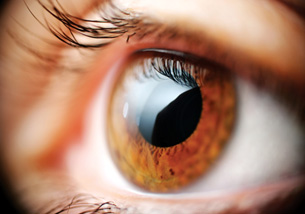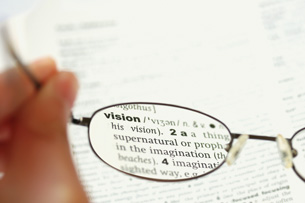Module 5
1. Module 5
1.24. Lesson 5
Module 5—Wave Theory of Light
Lesson 5—Refraction, Lenses, and Optical Systems
 Get Focused
Get Focused

© andrei nacu/shutterstock
The lens in your eye is part of an optical system that projects a clear image of the visual world onto the light-sensitive cells of your retina located at the back of your eye.
Light-sensitive rod cells and cone cells line the retina of the human eye in a very specific pattern. The rod cells, found throughout the retina, are sensitive to low levels of light and are used for primary vision in dark environments. The cone cells, found near the centre of the retina, are sensitive to various colours of light (wavelength) and produce colour vision in normal light environments.

© Andrew Chin/shutterstock
To achieve clear vision, light rays must be refracted when they enter the eye to accommodate the distribution of various light-sensitive cells in the retina at the back of the eye. Most of the light is directed at the fovea, a small region on the retina directly opposite the lens, which has a very high density of cone receptors. The light is focused in this region due to refraction that occurs as light enters the eye through the cornea and again as it passes through the lens.
The process is similar to that of a camera, which uses lenses to focus light on other photosensitive materials, such as film or electronic sensors.
Subtle changes or irregularities in the shape of the lens change the direction of the refracted light, which can cause impaired vision, such as near- and far-sightedness. In these cases, external lenses, such as glasses or contact lenses can be used to correct the path of the light. These lenses refocus the image clearly on the light-sensitive areas of the retina.
In essence, glasses are custom-designed lenses that correct imperfections in the natural lens of the eye to restore image formation on the retina. This complex process can be understood in terms of ray diagrams and refraction through thin lenses.
In this lesson you will answer the following essential questions:
- What is a thin lens?
- How are ray diagrams used to predict image characteristics for thin lenses?
- How is the thin lens equation used to predict image characteristics for thin lenses?
 Module 5: Lesson 5 Assignment
Module 5: Lesson 5 Assignment
Your teacher-marked Module 5: Lesson 5 Assignment requires you to submit responses to the following:
- Laboratory—LAB 1 and LAB 2
- Assignment—A 1, A 2, and A 3
- Discuss—D 3
The other questions in this lesson are not marked by the teacher; however, you should still answer these questions. The Self-Check and Try This questions are placed in this lesson to help you review important information and build key concepts that may be applied in future lessons.
After a discussion with your teacher, you must decide what to do with the questions that are not part of your assignment. For example, you may decide to submit to your teacher the responses to Try This questions that are not marked. You should record the answers to all the questions in this lesson and place those answers in your course folder.